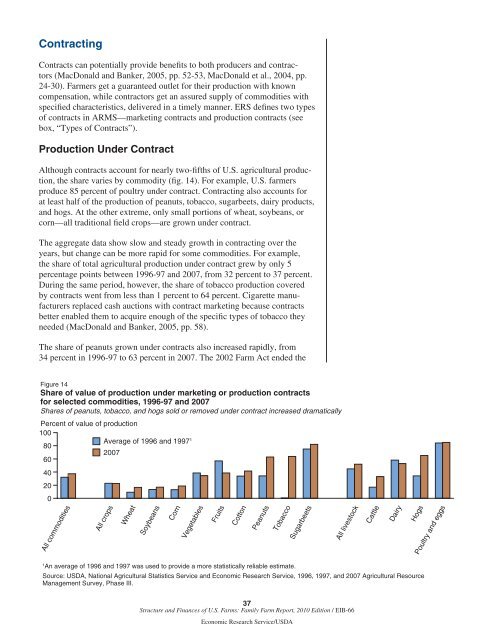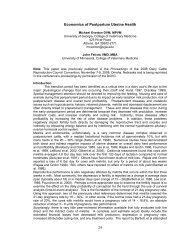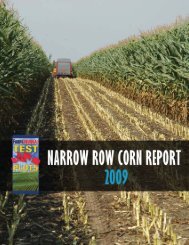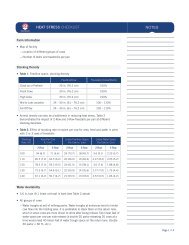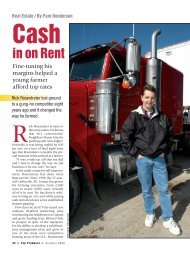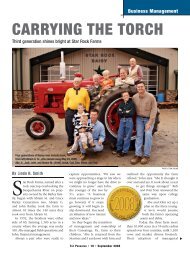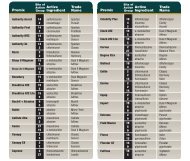Structure and Finances of U.S. Farms: Family Farm Report ... - AgWeb
Structure and Finances of U.S. Farms: Family Farm Report ... - AgWeb
Structure and Finances of U.S. Farms: Family Farm Report ... - AgWeb
Create successful ePaper yourself
Turn your PDF publications into a flip-book with our unique Google optimized e-Paper software.
ContractingContracts can potentially provide benefits to both producers <strong>and</strong> contractors(MacDonald <strong>and</strong> Banker, 2005, pp. 52-53, MacDonald et al., 2004, pp.24-30). <strong>Farm</strong>ers get a guaranteed outlet for their production with knowncompensation, while contractors get an assured supply <strong>of</strong> commodities withspecified characteristics, delivered in a timely manner. ERS defines two types<strong>of</strong> contracts in ARMS—marketing contracts <strong>and</strong> production contracts (seebox, “Types <strong>of</strong> Contracts”).Production Under ContractAlthough contracts account for nearly two-fifths <strong>of</strong> U.S. agricultural production,the share varies by commodity (fig. 14). For example, U.S. farmersproduce 85 percent <strong>of</strong> poultry under contract. Contracting also accounts forat least half <strong>of</strong> the production <strong>of</strong> peanuts, tobacco, sugarbeets, dairy products,<strong>and</strong> hogs. At the other extreme, only small portions <strong>of</strong> wheat, soybeans, orcorn—all traditional field crops—are grown under contract.The aggregate data show slow <strong>and</strong> steady growth in contracting over theyears, but change can be more rapid for some commodities. For example,the share <strong>of</strong> total agricultural production under contract grew by only 5percentage points between 1996-97 <strong>and</strong> 2007, from 32 percent to 37 percent.During the same period, however, the share <strong>of</strong> tobacco production coveredby contracts went from less than 1 percent to 64 percent. Cigarette manufacturersreplaced cash auctions with contract marketing because contractsbetter enabled them to acquire enough <strong>of</strong> the specific types <strong>of</strong> tobacco theyneeded (MacDonald <strong>and</strong> Banker, 2005, pp. 58).The share <strong>of</strong> peanuts grown under contracts also increased rapidly, from34 percent in 1996-97 to 63 percent in 2007. The 2002 <strong>Farm</strong> Act ended theFigure 14Share <strong>of</strong> value <strong>of</strong> production under marketing or production contractsfor selected commodities, 1996-97 <strong>and</strong> 2007Shares <strong>of</strong> peanuts, tobacco, <strong>and</strong> hogs sold or removed under contract increased dramaticallyPercent <strong>of</strong> value <strong>of</strong> production100Average <strong>of</strong> 1996 <strong>and</strong> 199780120076040200All commoditiesAll cropsWheatSoybeansCornVegetables1An average <strong>of</strong> 1996 <strong>and</strong> 1997 was used to provide a more statistically reliable estimate.FruitsCottonPeanutsTobaccoSugarbeetsAll livestockCattleDairyHogsPoultry <strong>and</strong> eggsSource: USDA, National Agricultural Statistics Service <strong>and</strong> Economic Research Service, 1996, 1997, <strong>and</strong> 2007 Agricultural ResourceManagement Survey, Phase III.37<strong>Structure</strong> <strong>and</strong> <strong>Finances</strong> <strong>of</strong> U.S. <strong><strong>Farm</strong>s</strong>: <strong>Family</strong> <strong>Farm</strong> <strong>Report</strong>, 2010 Edition / EIB-66Economic Research Service/USDA


